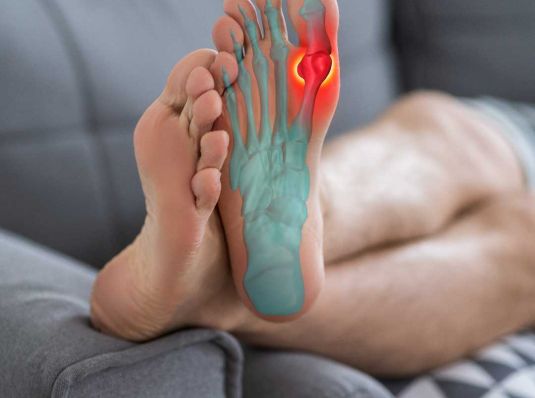Gout

What is Gout?
Gout is a subset of Arthritis that is caused by the needle-like crystals of uric acid in your joints, muscle, and/or skin. The crystals form because your body is either overproducing or under excreting uric acid, which can then group together to form structures that can cause large amounts of pain. Gout typically manifests in 'episodes', which can last from several days to a week. However, there may be as many as several years in between outbreaks in affected persons.
Facts About Gout
- A little less than 1 out of 100 people in the U.S. have or will have gout at some point.
Causes
- Overproduction of uric acid
- Certain medications
- Under excretion of uric acid
Risk Factors
- Obesity
- Age
- Thyroid malfunctions
- Exposure to lead
- Certain muscle medications
- diuretics
- cyclosporine
- aspirin
- levodopa
- vegetables with purine are fine
- calf tongue
- purine - rich diet
- dairy products appear to be good
- organ meats increase risk
- liver meat
- Family history
- Being male
- Drinking large amounts of beer
- Organ transplants
Symptoms
There are several stages of gout, which are marked by different symptoms:
- Asymptomatic tissue deposition
- Typically no overt symptoms of arthritis, but hyperuricemia is present
- Grout crystals may have formed, but aren't causing flares
- Typically no overt symptoms of arthritis, but hyperuricemia is present
- Acute Flairs
- Can last for days to weeks
- Present with:
- Pain
- Swelling
- Usually in joint of big toe
- Can be many joints in elderly
- Intercritical Segments:
- After acute flairs, grout can be inactive
- Without treatment, there will be another flare
- Interval between flairs will decrease over time
- Hyperuricemia continues
- After acute flairs, grout can be inactive
- Chronic Grout:
- Forms of chronic arthritis
- sore / aching joints
- Tophi may form in cooler parts of body
- Elbows
- Finger Joints
- Knees
- Outer Ear
- Toes
- Forms of chronic arthritis
Treatments
- Hyperuricemia Medication
- Physical Therapy
- Occupational Therapy
- Splints
- Education
- Weight Loss
- Surgery
- Joint-Assistive Aids
Resources
- The Center for Disease Control has more detailed information and facts on gout.
Sources
- Choi, Hyon K. "The New England Journal of Medicine. Purine-Rich Foods, Dairy and Protein Intake, and the Risk of Gout in Men - NEJM. New England Journal of Medicine, 11 Mar. 2004. Web. 21 May 2013.
- Center for Disease Control
CIS does not provide medical advice, diagnosis or treatment. The content provided is for informational purposes only.
Back To Health Education